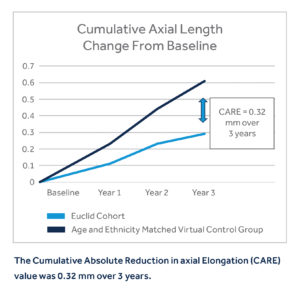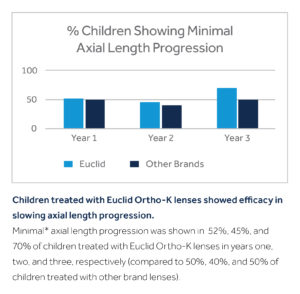sponsored content
January 16, 2023
This study offers a glimpse into the workings of one of the largest myopia referral practices in the U.S. and the performance of Euclid lens designs. Partnering with eye care providers to achieve patient satisfaction is at the heart of Euclid’s mission to slow the global myopia epidemic.
A recent U.S.-based, multi-site myopia management study demonstrated that orthokeratology, in general, and Euclid Vision’s Euclid Emerald and Euclid Emerald Toric OrthoK lenses were effective in managing pediatric myopia. Treehouse Eyes, one of the largest myopia referral practices in the U.S., facilitated the Clinical Algorithm for Myopia Progression (CAMP) study,1 which analyzed the results of 342 children with myopia who were treated and followed over a three-year period. Patients in this retrospective analysis were managed using a variety of treatment options, including OrthoK, soft multifocal contact lenses, low-dose atropine, and in some cases, a combination of these treatments. The most prescribed modality was overnight OrthoK, with 188 of the 342 children started in that modality, and Euclid designs accounted for 84% of the children who were prescribed OrthoK.
Axial Length Elongation
Minimal axial length (AL) elongation (defined as less than or equal to 0.10 mm per year) was observed in 70% of patients wearing Euclid lenses at year three.
- Minimal AL elongation was seen in 52%, 45%, and 70% of patients wearing Euclid OrthoK lenses in years one, two, and three, respectively, compared to 50%, 40%, and 50% of patients wearing other brands of OrthoK lenses. While minimal AL elongation for the first two years between these two treatments is comparable, there is a significant improvement in minimal AL elongation experienced at year three follow-up visits with patients wearing Euclid OrthoK lenses.
- The Cumulative Absolute Reduction in axial Elongation (CARE)2 value of patients treated with Euclid OrthoK lenses at year three was 0.32 mm,3 showing a similar reduction value to large-scale studies with non-OrthoK modalities.4
This finding is central to the study because AL elongation is the most important factor in myopia progression. Research shows that a 1.00D increase in myopia is associated with a 67% increase in myopic maculopathy (MM) — the leading cause of bilateral vision impairment and the most serious complication of myopia — and that slowing myopia progression by just 1.00D can reduce the likelihood of MM by 40%.5
 |
Refractive Error Change
When assessing myopic progression, it is crucial to analyze both refractive error and AL data; however, refractive error is a less-reliable indicator of OrthoK efficacy. AL monitoring can capture a more precise picture of the patient’s myopic progression because OrthoK intentionally alters the corneal surface. Despite this, it is worth noting that in this study, OrthoK treatment showed a greater reduction in the amount of myopic refractive error change (less than or equal to 0.25D per year) compared to the other treatment options.
Treatment Continuity
Another critically important finding in this study was that the lowest dropout rate was seen in OrthoK patients. The majority (78%) of the patients treated with OrthoK lenses remained with this treatment modality throughout the study duration. In contrast, 68% of patients wearing multifocal soft contact lenses and 22% of patients prescribed atropine alone did not change treatment modality. This finding suggests that not only are OrthoK lenses a popular initial treatment choice, but patients and their families are comfortable continuing throughout the prescribed course of treatment. Adherence to a prescribed course of treatment is associated with a high degree of treatment success. Therefore, keeping children in myopia treatment consistently during the most critical years is potentially predictive of better outcomes.
Euclid’s Mission
For over 20 years, OrthoK has been cited in the literature as an effective myopia management modality, with a long-standing safety record around the globe. Now, this study offers a glimpse into the workings of one of the largest myopia referral practices in the U.S. and the performance of Euclid lens designs. Of all the OrthoK patients, 84% were fit in Euclid-branded lenses. Partnering with eye care providers to achieve patient satisfaction is at the heart of Euclid’s mission to slow the global myopia epidemic.
Eye care practitioners echo the importance of being able to rely on Euclid as a partner in myopia management. “Euclid is most often my ‘go-to’ lens company, as I feel I can trust their products and advice from start to finish,” said Azinda Morrow, OD, FAAO. “The accuracy of the first empirical lens order is very impressive, and it may often be the final lens for the patient. In the more challenging cases, the consultation team is incredibly helpful in guiding me through the process,” she explained.
“My firsthand experience as a clinician using Euclid lenses has helped me provide a seamless OrthoK experience and streamlined care for my patients. It is a game-changer in the space of pediatric myopia care,” said Kevin Chan, OD, MS, FAAO, Sr. Clinical Director, Treehouse Eyes.
This study demonstrates that Euclid Vision’s proprietary designs can result in the successful management of myopia and strong patient acceptance.
References
- Cooper J, Aller T, Smith EL 3rd, Chan K, Dillehay SM, O’Connor B. Retrospective Analysis of a Clinical Algorithm for Managing Childhood Myopia Progression. Optom Vis Sci. 2022 Dec 22.
- Brennan NA, Toubouti YM, Cheng X, Bullimore MA. Efficacy in myopia control. Prog Retin Eye Res. Published online November 2020:100923. doi:10.1016/j.preteyeres.2020.100923
- Data on file.
- Chamberlain P, Peixoto-de-Matos SC, Logan NS et al. A 3-year Randomized Clinical Trial of MiSight Lenses for Myopia Control. Optom Vis Sci 2019;96:556-567.
- Bullimore MA, Brennan NA. Myopia Control: Why Each Diopter Matters. Optom Vis Sci. 2019;96(6):463-465.















